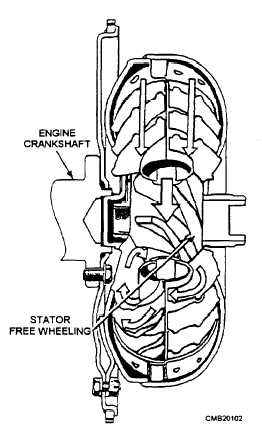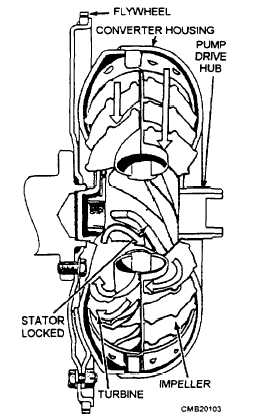the stator and impeller in the housing. The turbine is not fastened to the impeller but is free to turn independently. Oil is the only connection between the two.
4. Stator - designed to improve oil circulation inside the torque converter. Increases efficiency and torque by causing the oil to swirl around the inside of the housing.
The primary action of the torque converter results from the action of the impeller passing oil at an angle into the blades of the turbine. The oil pushes against the faces of the turbine vanes, causing the turbine to rotate in the same direction as the impeller (fig. 4-25). With the engine idling, the impeller spins slowly. Only a small amount of oil is thrown into the stator and turbine. Not enough force is developed inside the torque converter to spin the turbine. The vehicle remains stationary with the transmission in gear.
During acceleration, the engine crankshaft, the converter housing, and the impeller begin to move faster. More oil is thrown out by centrifugal force, turning the turbine. As a result, the transmission input shaft and vehicle starts to move, but with some slippage.

Figure 4-25. - Torque converter in fluid coupling stage.
At cruising speeds, the impeller and turbine spin at almost the same speed with very little slippage. When the impeller is spun fast enough, centrifugal force throws oil out hard enough to almost lock the impeller and turbine. After the oil has imparted its force to the turbine, the oil follows the contour of the turbine shell and blades so that it leaves the center section of the turbine spinning counterclockwise.
Because the turbine has absorbed the force required to reverse the direction of the clockwise spinning of the oil, it now has greater force than is being delivered by the engine. The process of multiplying engine torque has begun,
Torque multiplication refers to the ability of a torque converter to increase the amount of engine torque applied to the transmission input shaft. Torque multiplication occurs when the impeller is spinning faster than the turbine (fig. 4-26). For example, if the engine is accelerated quickly, the engine and impeller rpm might increase rapidly while the turbine is almost stationary. This is known as stall speed. Stall speed of a torque converter occurs when the impeller is at maximum speed without rotation of the turbine. This condition causes the transmission fluid to be thrown

Figure 4-26. - Torque converter in torque multiplication
Continue Reading